1840-1860 Chapter VIII MATERIAL PROGRESS
CHAPTER VIII.
MATERIAL PROGRESS
The population of the United States in 1860 was 31,443,321. In spite of the threatening political complications between 1840 and 1860, these years were characterized by astonishing economic prosperity. The decade after 1848 was, indeed, in point of advance in material weal, the golden age of our history. Between 1850 and 1860, the wealth of the nation swelled 120 per cent., the value of its farms 103 per cent., its total manufacturing product 87 per cent., its manufactured export 171 per cent., its railroad mileage 220 per cent. Making all due allowance for the rise of prices during the period, this is still a remarkable exhibit.
The great West continued to come under the hand of civilization. Between 1850 and 1860 our centre of population made a longer stride westward than during any other decade--from east of the meridian of Parkersburg, W. Va., to the meridian of Chillicothe, O.
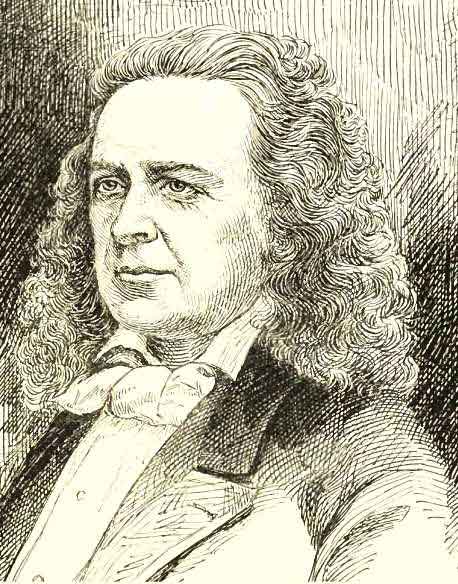
Elias Howe.
Florida and Texas having been admitted to statehood in 1845, Iowa followed next year, Wisconsin in 1848, California in 1850, Minnesota, which had been an organized Territory since 1849, in 1858, and Oregon in 1859. Kansas, Nebraska, Utah, and Washington Territories were organized before 1860. By this date there were settlements far up the Rio Grande. The Pacific coast was sought for lands and homes as well as for gold. Fremont's expeditions in 1842, 1844, and 1848 had done much to show people the way thither. In 1853 the Government sent out four different parties to survey suitable routes for a Pacific railway, a work followed up by three other parties the next summer. The settlements in Oregon had, by 1845, in places become dense.
Immigration hither was unfortunately checked a little later by Indian hostilities, the gravest attacks being in 1847 and 1855. In the latter year Major Haller, leading an exploring party, was surrounded by the savages and cut off from food and water, only making his escape by a fight of two days against overwhelming odds.

The Vandalia. The Pioneer Propeller On the Lakes.
He and his party at last hewed their desperate way through, losing their entire outfit, besides one-fifth of their number. The whole territory was harassed by Indians on the war path, and General Wool had to be sent up from San Francisco to restore peace. This done, immigration was renewed. A thousand new inhabitants came to Oregon in 1852, and its northern half was organized as Washington Territory the following year.

Old Stone Towers of the Niagara Suspension Bridge.
The Pacific Mail Steamship Company had been chartered in 1848, and four years earlier a newspaper started, the first in English on that coast. Its seat was Oregon City, its name the Flumgudgeon Gazette.
The old West prospered, notwithstanding the drain which it, in common with the East, experienced in favor of parts farther toward the setting sun. The first lake propeller was launched at Cleveland in 1847. The same year the Tribune was started in Chicago. In 1850 the city had its theatre and its board of trade. The Chicago streets began this year to be lighted with gas. The first bridge across the Mississippi was built in 1855 at Minneapolis; that at Rock Island, 1,582 feet long, in 1856. The Niagara suspension bridge was finished in 1855.
The increase of railways did not at once end the opening of canals. The Miami Canal, between Cincinnati and Toledo, 215 miles, begun in 1825, was finished in 1843, and the Wabash and Erie, between Evansville and Toledo, opened in 1851; but the Middlesex Canal in Massachusetts was, in 1853, abandoned and filled up from the loss of its business to railroads. In 1857 the Pennsylvania Railroad Company purchased from the State the canal and railway line from Philadelphia to Pittsburgh, and soon after extended the railway portion to cover the whole.
VOL. III.--18
A traveller from Boston to the West could get to Rochester by rail in 1841. Next year he could go on to Buffalo by the same means. In 1842, Augusta, Ga., was connected by rail with Atlanta, Savannah with Macon, and the Boston & Maine Railway finished to Berwick.
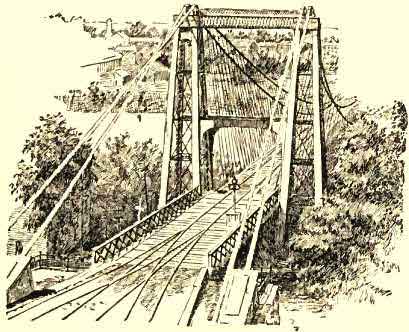
The New Iron Towers of the Niagara Bridge.
The first railway out of Chicago--it was the first in Illinois--was built in 1850, to Elgin. Chicago had no railway connection with the East till two years later, when the Michigan Southern was opened. The Michigan Central was finished soon after the Southern, and the Rock Island before the end of the year. The Michigan Central had direct connection east across Canada to Niagara Falls by 1854.

Birthplace of S. F. B. Morse, at Charlestown, Mass. Built 1775.
In 1856 the Burlington route reached the Mississippi and the Rock Island went on to Iowa City. This year witnessed the opening of the first railroad in California--from Sacramento to Folsom. In 1857 Chicago and St. Louis were joined by rails, as also the latter city with Baltimore, over the Parkersburg branch of the Baltimore & Ohio.
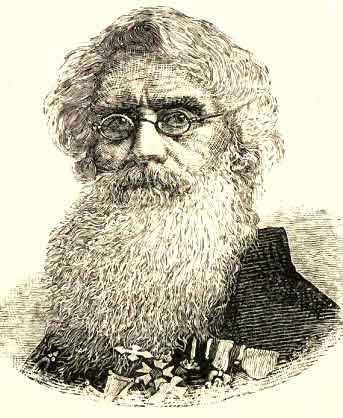
S. F. B. Morse.
We now come to an improvement of which the preceding period knew nothing, the magnetic telegraph, introduced by Professor Morse in 1844. In this year Morse secured a congressional appropriation of $30,000 for a line from Washington to Baltimore. The wires were at first encased in tubes underground.
In spite of the success of the project, further governmental patronage was refused, the Postmaster-General advising against it under the conviction that the invention could not become practically valuable. Morse appealed for aid from private capitalists. Ezra Cornell, of New York, soon opened a short line in Boston for exhibition, following this with a similar enterprise in New York City. The admission fee was twelve and a half cents. Few cared to pay even this trifle, so that the undertaking was hardly a success in either city.
Amos Kendall then engaged as Morse's agent, and by dint of great effort secured subscriptions for a line from New York to Philadelphia, being obliged to sell the shares for one-half their face value. Incorporation was secured from the Maryland Legislature, under the first American charter, for the telegraph business. The line was completed in 1845 to the Hudson opposite the upper end of Manhattan Island, and an effort made to insulate the wire and connect with the city along the bottom of the river. This failed, and for some time messages had to be taken over in boats. In 1846 the wire was carried on to Baltimore.

The First Telegraphic Instrument, as exhibited in 1837 by Morse.
In the same year Philadelphia and Pittsburgh were connected by telegraph, New York and Albany, New York and Boston, Boston and Buffalo. The first line in California was erected in 1853.
In 1850 Hiram Sibley embarked in the telegraph business. He bought the House patent, and next year organized the New York and Mississippi Valley Telegraph Company. By 1853 or 1854, some twenty companies had started, with a capital of $7,000,000--too many for good management or high profits.
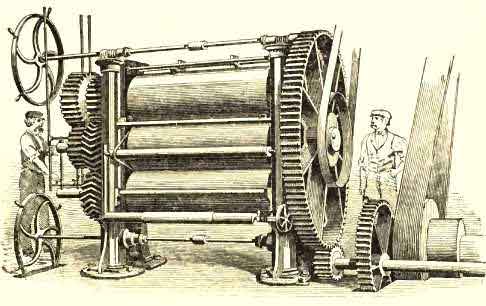
Calenders heated internally by Steam, for spreading India Rubber into
Sheets or upon Cloth, called the "Chaffee Machine."
Accordingly, Sibley and Cornell united in buying them up, and thus formed, in 1856, the Western Union, which Sibley's energy extended all over the country east of the Rocky Mountains. In 1860 he went to Washington with a scheme for a transcontinental telegraph line, and secured from Congress a subsidy of $40,000 for ten years.
Just then the Overland Telegraph Company was started in San Francisco. It and Sibley united, breaking ground July 1, 1861, and proceeding at the rate of nearly ten miles of wire per day. On October 25th, telegraph wire stretched all the way between the two oceans. In 1864 this line was amalgamated with the WesternUnion.
Still more wonderful, ocean telegraphy was broached and made successful during these years. Tentative efforts to operate the current under water were made between Governor's Island and New York City so early as 1842. A copper wire was used, insulated with hemp string coated with India rubber and pitch. In 1846 a similar arrangement was encased in lead pipe. This device failed, and sub-aqueous telegraphy seems to have been for the time given up.
In 1854 Mr. Cyrus W. Field, of New York, with Peter Cooper and other capitalists of that city, organized the New York, Newfoundland, and London Telegraph Company, stock a million and a half dollars, and began plans to connect New York with St. Johns, Newfoundland, by a cable under the Gulf of St. Lawrence. Little progress was made, however, till 1857, when it was attempted to lay a cable across the Atlantic from Newfoundland. The paying out was begun at Queenstown and proceeded successfully until three hundred and thirty-five miles had been laid, when the cable parted. Nothing more was done till the next year in June. Then, in 1858, after several more unsuccessful efforts, the two continents were successfully joined. The two ships containing the cable met in mid-ocean, where it was spliced and the paying out begun in each direction. The one reached Newfoundland the same day, August 5th, on which the other reached Valencia, Ireland. No break had occurred, and after the necessary arrangements had been effected, the first message was transmitted on August 16th. It was from the Queen of Great Britain to the President of the United States, and read, "Glory to God in the highest, peace on earth and good will to men." A monster celebration of the event was had in New York next day.
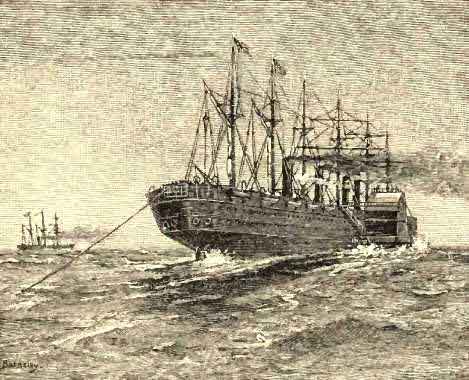
The Great Eastern Laying the Atlantic Cable.
Although inter-continental communication had been actually opened, the cable did not work, nor did ocean cabling become a successful and regular business till 1866, when a new cable was laid. This event attracted the more attention from the fact that the largest ship ever built was used in paying out the cable. It was the Great Eastern, 680 feet long and 83 broad, with 25,000 tons displacement.

Sounding Machine used by a Cable Expedition.
Street railways became common in our largest cities before 1860, the first in New England, that between Boston and Cambridge, dating from 1856. Sleeping-cars began to be used in 1858. The express business went on developing, being opened westward from Buffalo first in 1845.
A steam fire-engine was tried in New York in 1841, but the invention was successful only in 1853. Baltimore used one in 1858. Goodyear triumphantly vulcanized rubber in 1844, making serviceable a gum which had been used in various forms already but without ability to stand heat. Elias Howe took out his first patent for a sewing machine in 1846, being kept in vigorous fight against infringements for the next eight years. The anaesthetic power of ether was discovered in 1844. Gutta-percha was first imported hither in 1847. The first application of the Bessemer steel process in this country was made in New Jersey in 1856, the manufacture of watches by machinery begun in 1857, photo-lithography in 1859. New York had a clearing house in 1853, Boston in 1855. The petroleum business may with propriety be dated from 1860, although the existence of oil in Northwestern Pennsylvania had been long known, and some use made of it since 1826. For several years experiments had been making in refining the oil. The excellence of the light from it now drew attention to the value of the product, wells began to be bored and oil land sold for fabulous prices.
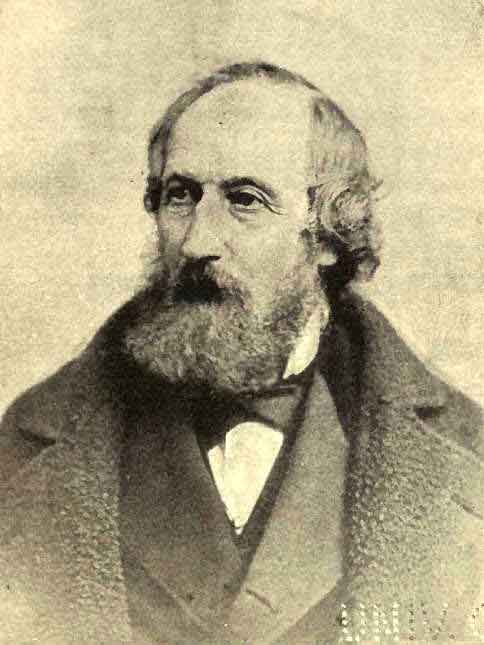
Cyrus W. Field.
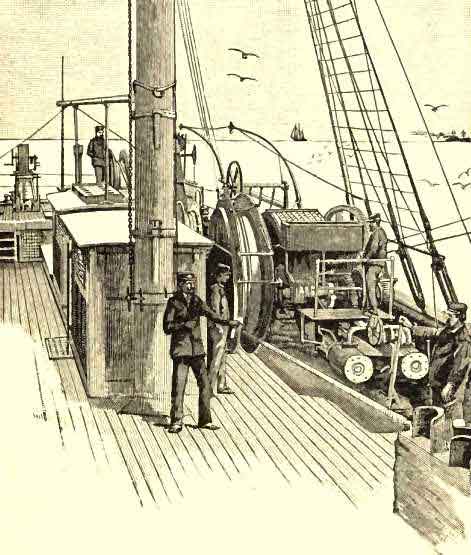
Paying out Cable Gear. From Chart House.
We close this chapter with a word about the painful financial crisis that swept over the country in the autumn of 1857. Its causes are somewhat occult, but two appear to have been the chief, viz., the over-rapid building of railroads and the speculation induced by the prosperity and the rise of prices incident to the new output of gold. Interest on the best securities rose to three, four, and five per cent. a month. On ordinary securities no money at all could be had. Commercial houses of the highest repute went down. The climax was in September and October.
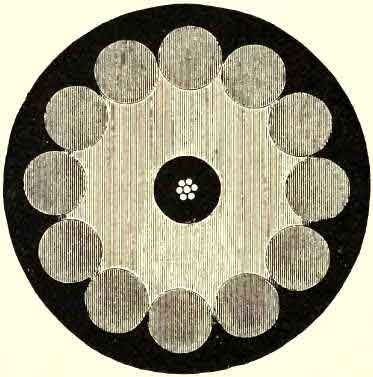
Shore End of Cable-exact size.
[About 3.5 inches in diameter.]
The three leading banks in Philadelphia suspended specie payments, at once followed in this by all the banks of the Middle States, and upon the 13th of the next month by the New York banks. Manufacturing was very largely abandoned for the time, at least thirty thousand operatives being thrown out of work in New York City alone. Prices even of agricultural produce fell enormously. Tramps were to be met on every road. Easier times fortunately returned by spring, when business resumed pretty nearly its former prosperous march.

Barnacles on Cable
VOL. III.--19


